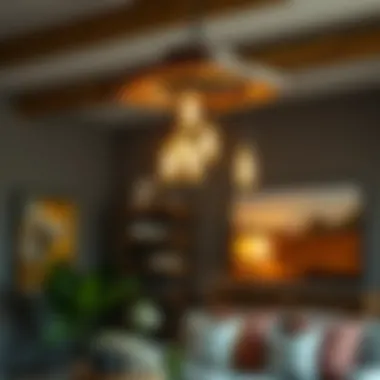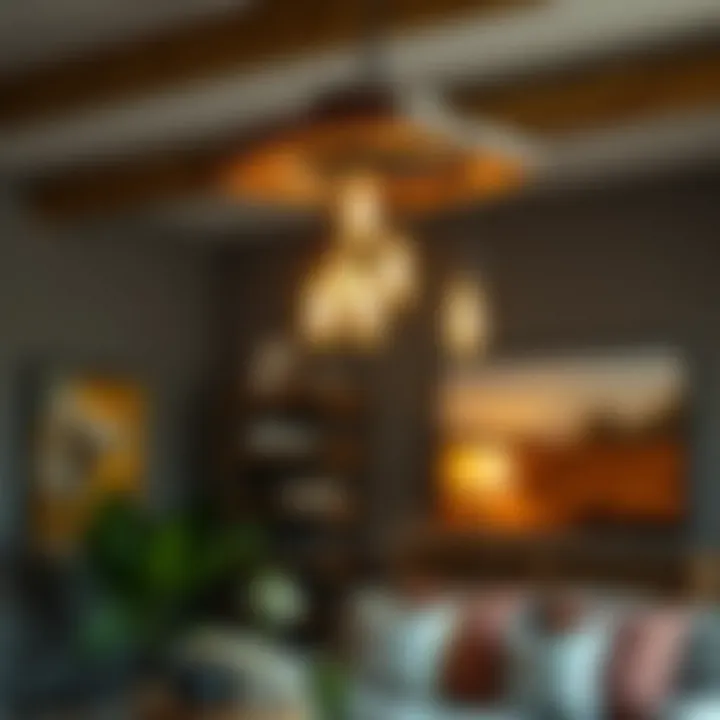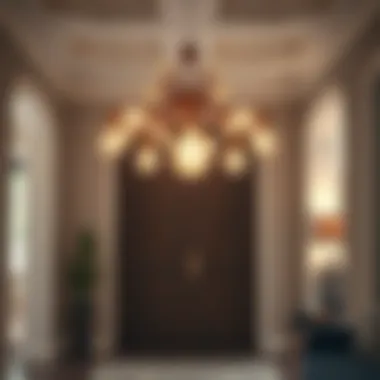Exploring Light Bulb Pendant Chandeliers in Modern Design


Intro
Light bulb pendant chandeliers have transcended their original purpose of mere illumination; today, they are pivotal design elements gracing both commercial and residential spaces. They serve as conversation starters, functions of art, and practical lighting solutions all in one. With various styles that cater to diverse aesthetic preferences, these fixtures can seamlessly integrate into any interior design scheme, whether it be modern, rustic, or eclectic.
Understanding the multifaceted nature of light bulb pendant chandeliers invites a deeper appreciation for both their beauty and functionality. Not only do they provide much-needed brightness, but the right pendant can also contribute to the overall atmosphere of a room, setting a warm tone or creating a focal point that draws the eye.
In this article, we'll take a detailed look at the latest trends shaping the world of light bulb pendant chandeliers. From their design styles to material choices, we’ll explore how these elements come together to create stunning fixtures that enhance any space. Furthermore, we’ll go over key considerations in choosing the right chandelier, ensuring that you make an informed purchase that complements your home or project.
So, whether you're a homeowner longing to revitalize your living area, an interior designer scouring for that perfect piece, or a DIY enthusiast taking matters into your own hands, this exploration of light bulb pendant chandeliers will provide the insights needed to elevate your interiors.
Preface to Light Bulb Pendant Chandeliers
Light bulb pendant chandeliers have surged in popularity, becoming a captivating centerpiece in modern interiors. Their ability to blend style and function represents a significant shift in how we perceive lighting in our spaces. They do more than illuminate; they accentuate architecture, draw the eye, and create an inviting atmosphere. Understanding this concept is essential for homeowners, designers, and DIY enthusiasts alike.
Definition and Overview
In simple terms, a light bulb pendant chandelier is a fixture that hangs from the ceiling, typically showcasing one or more light bulbs. Unlike traditional chandeliers adorned with crystals or shades, these pieces leverage the raw beauty of exposed bulbs. This straightforward design often plays a pivotal role in enhancing various decor styles, from rustic kitchens to sleek urban lofts. The sheer versatility of these chandeliers reflects a larger trend in interior design that favors open spaces, bold visuals, and an appreciation for light itself.
The Evolution of Pendant Lighting
From their origins in ancient times, where simple oil lamps hung from ceilings, the concept of pendant lighting has undergone an incredible metamorphosis. Fast forward to the present, and you'll find a myriad of designs that employ state-of-the-art technology without losing sight of the heritage behind lighting. Today’s light bulb pendant chandeliers often incorporate advancements like energy-efficient bulbs, smart home compatibility, and unique materials.
The journey hasn’t been linear; pendant lights have seen their fair shares of ups and downs in popularity. They’ve transitioned from being purely functional fixtures into aesthetic statements. People now appreciate how an intricately designed light bulb pendant can become a focal point in a room, illustrating their importance in the overall design narrative.
"Lighting is not just a utility; it’s a defining element in how we perceive our surroundings."
Whether it's creating a cozy nook in a dining area or adding flair to a bustling workspace, light bulb pendant chandeliers have cemented their status in contemporary home decor. They symbolize a harmonious marriage between beauty and practicality, allowing individuals to express their unique style while addressing the functional need for light.
As we venture further into this exploration, we will delve into the design variations, materials, and the latest trends, providing a comprehensive guide to choosing and caring for light bulb pendant chandeliers. This knowledge is crucial not only for enhancing aesthetic appeal but also for ensuring long-lasting functionality in your home.
Design Variations of Light Bulb Pendant Chandeliers
Exploring the design variations of light bulb pendant chandeliers is crucial, as it reveals how these fixtures can set the tone in any space. Each design variation serves distinct aesthetic and functional purposes, appealing to diverse tastes and home styles. Understanding these different categories enables homeowners and designers to make informed choices that resonate with their personal style while enhancing the overall ambiance of a room.
Industrial Style
The industrial style is characterized by its rugged charm and raw appeal. Typically featuring materials like exposed metal and distressed finishes, these fixtures often pay homage to old factories and warehouses. The beauty of industrial light bulb pendant chandeliers lies in their unfinished look that complements urban and loft-style interiors impeccably.
When selecting an industrial chandelier, consider the following:
- Look for fixtures with visible hardware or Edison bulbs to heighten the vintage vibe.
- Pair it with rustic furniture and exposed brick walls to maintain the theme.
- Keep in mind that less can be more with industrial designs; a statement piece can often carry a room.
Modern Minimalism
Modern minimalism focuses on simplicity and functionality, often featuring clean lines and a monochromatic color palette. A light bulb pendant chandelier in this style tends to be unobtrusive, yet striking in its singularity. The goal here is to focus on form and clean design over ornamental excess.
To achieve a modern minimalist look, consider these aspects:
- Choose fixtures with geometric shapes or straightforward designs, like a simple dome or a slender rod.
- Integrate neutral colors, such as white, black, or metallic tones, to maintain an uncluttered aesthetic.
- Ensure that the fixture offers practicality alongside style; look for chandeliers that provide ample light without overpowering the space.
Vintage Appeal
The vintage appeal in light bulb pendant chandeliers draws from past eras, often informed by the aesthetics of the 1920s through the 1960s. This design showcases ornate details, intricate patterns, and often colorful glass shades or frames. They serve as nostalgic reminders of a bygone time and infuse a room with character and warmth.
For those considering a vintage chandelier, keep the following in mind:
- Look for embellished glass work or decorative metal castings that can evoke the elegance of earlier designs.
- Select hues or materials that complement the existing décor to create a harmonious space.
- Vintage styles often pair well with traditional furnishings, so consider the overall cohesion in your room.
Eclectic Combinations


Eclectic combinations play a fun balancing act of mixing styles, bringing together various influences to create a unique fixture. This type of chandelier is perfect for those who value individuality and creativity in their home décor. An eclectic pendant light might blend vintage elements with modern materials or incorporate different shapes for a functional art piece.
When exploring eclectic designs, think about these elements:
- Experiment by pairing contrasting materials or designs to see what resonates with your aesthetic.
- Use color to bring life; this could mean bright shades, metallics, or even a mosaic of glass.
- Aim for a cohesive look despite the diversity; select a common color or motif to tie everything together.
Understanding and selecting the right design variation in light bulb pendant chandeliers can dramatically enhance not just the aesthetics but also the functionality of a space.
Material Considerations
When delving into light bulb pendant chandeliers, the choice of material is crucial. Each material not only contributes to the fixture's aesthetic but also to its functionality and longevity. Selecting the right material can define the ambiance of a space and also influence the maintenance requirements. Here’s a closer look at some of the popular materials used in these designs and what makes them distinct in the realm of interior lighting.
Glass: Clarity and Style
Glass is often the go-to choice for pendant fixtures, primarily because of its ability to enhance light diffusion. The clarity of glass allows for a higher quality of light, making spaces look more spacious and inviting. Depending on the design, glass can be molded into various shapes - from sleek, modern silhouettes to more intricate, artisanal patterns.
"Good design can be invisible, but when it shines, it can illuminate both a room and its purpose."
Additionally, glass can come in various finishes such as frosted or colored, offering a spectrum of effects. Frosted glass softens the harshness of light, making it ideal for creating a cozy atmosphere in dining spaces or living rooms. On the other hand, clear glass can create a stunning visual impact, especially when paired with vintage-style Edison bulbs which exude nostalgia. A blend of glass type can also be used to juxtapose styles—like mixing clear glass with colored accents for a more eclectic flair.
Metal: Durability and Aesthetics
Metal fixtures lend a touch of industrial elegance that fits seamlessly into modern and contemporary decor. Whether it’s brass, copper, or raw iron, metal's strength ensures longevity, making it a reliable option for any pendant chandelier.
Brass, for instance, ages beautifully, developing a patina that adds character over time. Its warm tone brings richness to spaces, creating a sense of warmth. Copper, with its bright and reflective surface, can create a striking contrast when paired with darker hues in a room. Additionally, metals can be finished in various ways such as matte, polished, or distressed, providing further options for customizability.
An important consideration with metal fixtures is their weight, which must be accounted for during installation. Ensure that the mounting hardware is sturdy enough to support the fixture's weight while ensuring safety.
Wood: A Natural Warmth
Wooden light bulb pendant chandeliers are great for those looking to introduce a rustic warmth into their interiors. The natural grains and textures found in wood can infuse spaces with coziness and charm. Whether it's reclaimed barn wood for a farmhouse look or sleek, modern wood designs, the versatility of wood suits various styles.
Considerations for wood-based fixtures include the type of finish, since some finishes can highlight the natural beauty of the wood while others might detract from it, making it look overly polished or artificial. Natural oils can be used to preserve the wood's integrity without compromising its organic feel.
Lighting Effects and Functionality
Understanding how light interacts with space is crucial when you delve into the world of light bulb pendant chandeliers. These fixtures do more than just hang from the ceiling; they significantly influence the ambiance of a room, providing a practical function alongside aesthetic appeal. The balance between lighting effects and functionality is vital in creating an inviting environment. The right combination of ambient, task, and accent lighting ensures that your light bulb pendant chandelier serves a purpose while elevating the room’s design.
Ambient Lighting
Ambient lighting acts as the foundation of illumination in a space. It provides a uniform light that fills the room, enabling movement and daily activities without straining the eyes. When thinking about light bulb pendant chandeliers, choosing a fixture designed for ambient light is essential. Often, these chandeliers feature multiple bulbs or a larger centerpiece that spreads light evenly.
Consider the following when incorporating ambient lighting:
- Fixture Placement: Positioning the chandelier at the right height, typically around 30 to 36 inches above the table, will enhance the spread of light.
- Bulb Types: Opting for warm LED bulbs creates a cozy atmosphere that’s perfect for living spaces.
- Design Elements: Styles with open designs can enhance the flow of light throughout the room, while enclosed fixtures may provide a more muted effect.
"Lighting is everything. It sets the mood, the tone, and even the emotional vibe of a room."
Task Lighting
Task lighting focuses on illuminating specific areas where activities such as reading, cooking, or working take place. When selecting a light bulb pendant chandelier for task lighting, consider your primary functions. For instance, installing a pendant directly above a kitchen island or workspace can make a world of difference.
Here are a couple of tips for effective task lighting:
- Adjustable Heights: Consider adjustable pendant chandeliers that allow you to direct light where it’s needed most.
- Light Color: Cooler tones, around 3000K to 4000K, can enhance focus and productivity, ideal for workspaces or kitchens.
Accent Lighting
Accent lighting aims to highlight specific features or objects in a space, like artwork, architectural elements, or decorative displays. Light bulb pendant chandeliers can be quite effective in creating depth and interest when used as accent lights. To achieve the desired effect:
- Layering: Use a combination of different lighting types to create a dynamic ambiance. Layering your light bulb chandelier with wall sconces or recessed lighting makes a room feel more engaging.
- Directionality: Choosing chandeliers that direct light downwards can showcase artwork or fixtures below, creating a dramatic effect.


In summary, the interplay of ambient, task, and accent lighting not only enhances the functionality of light bulb pendant chandeliers but also plays a critical role in shaping the overall aesthetic of your home. Ensuring that each lighting layer works harmoniously will result in a well-balanced and visually appealing space. Investing time in understanding these aspects will make all the difference when designing your ideal environment.
Installation Guidelines
When considering light bulb pendant chandeliers, understanding the installation process is crucial. This ensures not only effectiveness but also safety and aesthetic harmony within your space. A well-executed installation can enhance the overall feel of a room and allow you to fully enjoy the functionality and visual appeal these fixtures offer.
Measuring Ceiling Height
Measuring ceiling height is one of the first steps in your chandelier installation journey. Many overlook this simple yet vital task, leading to fixtures that either dangle too low or sit awkwardly high. Ideally, a pendant should hang about 30 to 36 inches above a table to foster a cozy atmosphere without obstructing sight lines.
To accurately gauge your ceiling height, consider the following:
- Use a reliable measuring tool: Whether it’s a tape measure or a laser level, ensure you have accuracy in your measurements.
- Account for the bulb size: Larger bulbs can influence how low a fixture needs to hang; you may want to allow for extra space to keep things looking tidy.
- Consider the room's purpose: In dining areas, a lower fixture can create intimacy, while a higher installation is better suited for open spaces or hallways.
Determining how high to hang your chandelier matters greatly. As a rule of thumb, take note of the room's overall dimensions and the furniture arrangement.
Electrical Considerations
A haphazard approach to electrical considerations can spell disaster, turning a stylish decor element into a safety hazard. Before diving into the installation, familiarize yourself with the electrical standards and requirements in your area. Clarity on these matters can save time and frustration later on.
Here’s what to keep in mind:
- Wiring: Ensure that the wiring in your ceiling can handle the load of your chosen chandelier. Check the wattage vs. the load capacity to prevent any potential fire hazards.
- Circuit breakers: Make sure the circuit is not overloaded with other fixtures. Each chandelier has its specific requirements, and knowing your home’s electrical layout is key.
- Professional help: If you're not confident about the wiring, it’s wise to call a licensed electrician. They can help install the chandelier while ensuring all safety standards are met.
Fixture Placement
Once your ceiling height and electrical issues are sorted, it’s time for fixture placement. Where you position your light can completely transform the ambiance of your space. The placement involves both aesthetic and practical considerations.
Consider these tips for optimal fixture placement:
- Assess sight lines: In spaces where people will congregate, avoid placing the chandelier too low, as it may obstruct views or cause discomfort.
- Think about focal points: A well-placed chandelier can serve as a centerpiece, drawing attention to designated areas, like a dining table or a living room seating arrangement.
- Layer your lighting: Incorporating various light sources can add depth and texture to your interior. Make sure your chandelier doesn’t compete with wall sconces or floor lamps.
"Light is a universal language; when arranged correctly, it speaks to those who enter your space."
By giving thought to these installation guidelines, you can craft an enchanting atmosphere with your light bulb pendant chandeliers while maintaining a focus on safety and practicality.
Maintenance and Care
When it comes to light bulb pendant chandeliers, maintenance and care are often overlooked, but they play a crucial role in ensuring these fixtures remain both functional and aesthetically pleasing over time. By developing a routine that prioritizes cleanliness and bulb efficiency, homeowners, designers, and DIY enthusiasts can preserve the beauty and longevity of their lighting choices.
Cleaning and maintaining these light fixtures not only enhance their appearance, but also ensure proper lighting performance. A layer of dust or grime can significantly reduce the brightness of the bulbs, making it harder to achieve the desired ambiance. Moreover, a well-cared-for chandelier can improve the overall atmosphere of a room by creating a visually appealing focal point.
Thus, understanding the specific maintenance needs associated with various materials used in light bulb chandeliers becomes essential. Different materials, whether glass, metal, or wood, each demand unique care strategies to avoid damage and maintain luster.
Additionally, bulb replacement is another key aspect of maintenance. Neglecting this part can lead to reduced effectiveness of the lighting design, affecting both mood and functionality in the space. Learning effective strategies for when and how to change bulbs ensures your chandelier keeps shining bright.
Cleaning Techniques for Different Materials
Cleaning a pendant chandelier is more than just wiping it down. The strategy varies depending on the material used.
- Glass Chandeliers: Always use a soft, lint-free cloth to avoid scratches. A mixture of mild soap and water works wonders on regular grime. For tougher spots, try a vinegar solution to restore clarity. Avoid using abrasive cleaners.
- Metal Chandeliers: For those crafted from metal, a gentle cleaner designed for the specific metal type is ideal. Brass, for instance, might need a suitable brass polish to avoid tarnishing, while chrome or nickel can be cleaned with a simple soap solution.
- Wood Chandeliers: These require a soft cloth dampened with a wood-friendly cleaner, ensuring you don’t soak the wood. Be cautious of heavy cleaning products, as they can damage the finish over time.
Regularly dusting the chandelier can reduce the need for deeper cleaning, thus prolonging the beauty and integrity of the materials.
Bulb Replacement Strategies
Replacing the bulbs in your pendant chandelier might sound straightforward, yet it can be a bit tricky without a solid strategy.
- Wonder What Type of Bulb to Use: It's wise to consult the manufacturer's guidelines or labels for wattage limits. This helps prevent overheating or potential malfunction. The latest trend is toward energy-efficient options like LED bulbs, known for their longevity and low heat.
- Plan for Timing: Keeping an eye on the brightness can signal when it’s time for a change. If your fixture starts flickering or dimming, that’s usually a telltale sign. Replacing bulbs in sets can help maintain an even lighting quality across the chandelier.
- Safety First: Remember to turn off the power before replacing any bulbs. Doing so prevents potential electric shocks during the process. Using a sturdy ladder or step stool ensures access to higher chandeliers without risking an accident.


Tip: Marking the bulb replacement dates on a calendar can help track when it’s time for a change, keeping your chandelier shining like new.
By prioritizing maintenance and care, you can ensure your light bulb pendant chandelier not only retains its functionality but also continues to serve as a stunning centerpiece within your home.
Trends in Lighting Design
Lighting design has undergone transformative phases in recent years, and light bulb pendant chandeliers reflect this evolution. These fixtures are more than mere sources of light; they represent a blend of aesthetics and functionality that adapts to the changing tastes of homeowners and designers. Trends in lighting design greatly influence how spaces are perceived, offering opportunities for personal expression while integrating practical needs. Understanding these trends helps individuals make informed decisions when selecting lighting options that resonate with their style and functional requirements.
Sustainable Practices in Lighting
In an era where sustainability is at the forefront of many purchasing decisions, light bulb pendant chandeliers are evolving to embrace eco-friendly practices.
- Energy-Efficient Bulbs: The importance of using energy-efficient light bulbs cannot be understated. LED bulbs not only consume up to 80% less energy than traditional incandescent options but also have a longer lifespan, reducing waste and maintenance efforts. This shift towards energy conservation is a win-win for the environment and the wallet.
- Recycled Materials: Designers are increasingly sourcing materials that minimize environmental impact. Metal from recycled sources or glass made from post-consumer waste is becoming more common in chandelier designs. These choices do not only lower the carbon footprint but also create unique pieces with stories to tell.
- Sustainable Manufacturing Practices: Companies are now focusing on reducing their environmental impact throughout the production process. This includes using non-toxic paint, reducing water usage, and ensuring safe working conditions. Potential buyers are more inclined to support brands that are committed to responsible practices.
Such sustainable approaches are shaping the landscape of lighting design. They encourage homeowners to think twice about their lighting choices, factoring in long-term benefits for both their homes and the planet.
Smart Lighting Technology
With technology rapidly advancing, smart lighting has carved a niche in the world of lighting design. Pendant chandeliers are no exception to this trend. Homeowners and designers alike are beginning to appreciate the benefits of integrating smart technology into their lighting setups.
- Remote Control and Automation: Imagine adjusting your chandelier's brightness or color temperature with the touch of a button, or even through voice commands. Smart bulbs are programmable and can be controlled via mobile applications or smart home systems like Google Home or Amazon Alexa. This offers convenience and customization, letting users tailor their ambiance to mood or function.
- Energy Monitoring: Many smart lighting systems provide insights into energy consumption. Homeowners can track usage patterns and make adjustments to save on energy bills while maintaining desired lighting levels. This not only contributes to sustainable practices but also promotes financial empowerment.
- Integration with Home Systems: Smart chandeliers can seamlessly integrate into existing home automation systems, connecting with security, heating, and cooling devices. This interconnectivity opens up opportunities for creating dynamic moods or enhancing safety when paired with other smart technologies.
Adopting smart lighting technology offers adaptability and personalization, turning chandeliers into functional art pieces that enhance everyday living. By being aware of these lighting design trends, individuals can create spaces that reflect their personal tastes while considering sustainability and innovation.
Incorporating Light Bulb Pendant Chandeliers into Your Home
Incorporating light bulb pendant chandeliers into your home is more than a decision about lighting; it’s about creating an atmosphere that reflects your personal style while enhancing the functionality of your spaces. These fixtures serve as both illumination and decorative elements, making them a dual-purpose addition to any room. As light bulb pendant chandeliers come in a plethora of styles, sizes, and materials, selecting the perfect fit can really impact the feel of a space.
Choosing the Right Style for Your Room
Selecting the right style of pendant chandelier is akin to picking the right accessory for an outfit. The key isn't just about aesthetics; it's about harmonizing your choice with existing decor.
- Consider the overall theme: If your home embraces a minimalist design, a sleek, modern pendant with clean lines may be ideal. For a rustic aesthetic, wood and metal combinations could hit the mark.
- Room function: A vibrant, artistic fixture might liven up a dining area, while a more subdued design could be better suited for a cozy reading nook.
- Scale and proportion: Large chandeliers can dominate smaller rooms and overwhelm spaces with lower ceilings. Conversely, tiny fixtures might get lost in a grander space.
Effective placement can enhance both beauty and utility, ensuring the light fixture’s style aligns with the room’s character.
Pairing with Other Fixtures
When integrating a light bulb pendant chandelier into your home, considering the other lighting fixtures in the room is crucial. This may sound obvious, but it’s easy to overlook how these accents interact with each other.
- Complementary styles: Pairing a minimalist pendant with sleek sconces can ensure a cohesive look. If your pendant has intricate designs, you’ll want to select simpler fixtures that don’t create visual chaos.
- Layering light: Utilize a mix of ambient, task, and accent lighting to create depth. For instance, a bright bulb chandelier paired with LED lights can offer flexibility depending on the occasion.
- Color coordination: If the pendant is a bold color or finish, balance it with neutral-colored fixtures. This ensures that the chandelier stands out without clashing with its counterparts.
Creating Focal Points with Lighting
A well-positioned chandelier can create stunning focal points that draw the eye and anchor a room’s design.
"Lighting is the silent architect of a room; it shapes, softens, and highlights the beauty of an environment."
- Strategic placement: Positioning a pendant chandelier over a dining table or in a foyer can instantly create a welcoming atmosphere. Consider also using multiple pendants in a row for linear arrangements that enhance visual interest.
- Height matters: Installing the chandelier at the right height is vital. Too low, and it risks obstructing movement; too high, and it loses its impact. A general rule of thumb is to keep it seven feet above the floor to allow for comfortable clearance.
- Contrast with surroundings: If your room features a lot of symmetry, a unique pendant can act as an eye-catching counterpoint. Alternatively, within eclectic designs, a trendy light can act as a bridge between different styles.
In all these aspects, thoughtful integration of light bulb pendant chandeliers can transform your home, merging form with function while making a definitive design statement that sets the tone for any gathering.
Ending
The significance of lighting in our living spaces cannot be understated. It goes beyond mere illumination; it shapes the ambiance and influences the mood within a room. As we've explored throughout this article, light bulb pendant chandeliers stand at the intersection of design, functionality, and emotion. This last section synthesizes crucial insights about these dynamic fixtures and outlines their worth in modern home styling.
The Lasting Impact of Thoughtful Lighting Choices
Choosing the right light bulb pendant chandelier goes way past just selecting a nice-looking piece. A well-considered lighting fixture can enhance the aesthetics of a space while also providing crucial functionality. Think about it—this is the sort of decision that can knit together the various elements of design within a room.
Benefits of Thoughtful Lighting Choices:
- Aesthetic Enhancement: A thoughtfully chosen chandelier can become the focal point of a room, drawing the eye and encouraging appreciation for surrounding décor.
- Improved Functionality: Depending on the type of bulbs used and their placements, these chandeliers can enhance visibility, making spaces feel larger and more inviting.
- Mood Setting: Light affects how we feel. Warmer hues promote relaxation, while cooler tones can boost energy. Choosing the appropriate lighting can influence the atmosphere you wish to create.
When designing a space, one should never underestimate the power of light. An eclectic blend of materials, styles, and functionalities in light bulb pendant chandeliers can enhance the room’s appeal and improve day-to-day living experiences. Hence, taking the time to make informed decisions regarding these fixtures can result in a captivating and harmonious home environment.
For more details on how lighting affects interior design, check resources like Britannica or Wikipedia on Interior Design. Engaging in community discussions on platforms like Reddit can also offer fresh insights and ideas.















